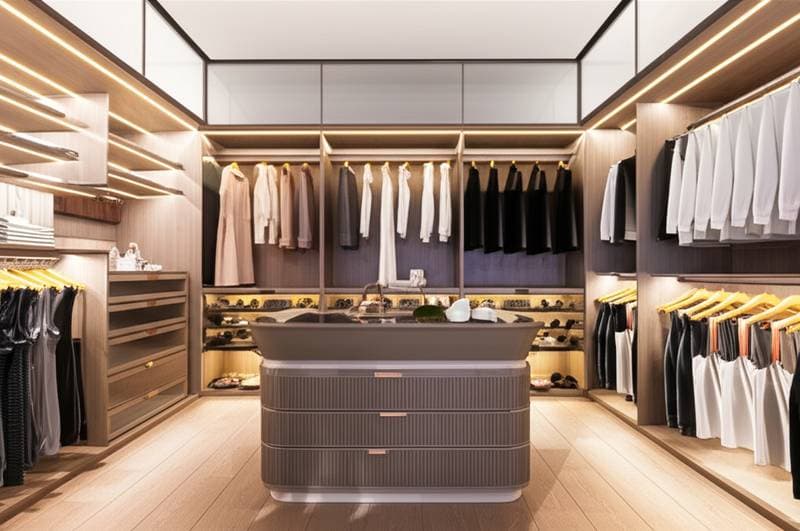LED Color Temperatures That Elevate Wardrobe Appeal in Luxe Closets
Lighting profoundly influences wardrobe perception. The appropriate LED color temperature renders a silk blouse radiant, a tailored jacket sharp, and jewelry sparkling like in a high-end store. In luxury closets, lighting serves as a design element that shapes how garments appear, how they feel to the touch, and how frequently they are selected. Whether constructing a custom dressing area or enhancing a basic closet, mastering color temperature creates an indulgent yet efficient space.
Why Color Temperature Matters
Color temperature refers to light tone, measured in Kelvin. Lower values produce warmer, amber hues, while higher values yield cooler, bluish tones. In closets, this factor dictates fabric authenticity. A cream sweater might shift to yellow or gray depending on the bulb.
The objective involves selecting lighting that enhances both clothing and the individual selecting it. Designers liken closet illumination to gallery setups, where texture and color demand precision. However, closets require added warmth for comfort. Individuals prepare for the day or relax in the evening, so superior lighting merges clarity with gentleness.
At a Glance
- Ideal range: 3000K to 4000K
- Best for: Accurate wardrobe viewing, precise fabric rendering, and upscale ambiance
- Common fixture types: LED strips, recessed downlights, puck lights, and rod-integrated systems
- Budget range: Basic LED strip upgrades start at fifty dollars; custom installations surpass several thousand dollars
- Skill level: Accessible for DIY projects or professional installations
The Warm Zone: 2700K to 3000K
Warm white light from 2700K to 3000K evokes invitation and intimacy. It mirrors the gentle radiance of incandescent bulbs. This spectrum enhances skin tones and builds a cozy environment, complementing elements like walnut shelves or brass accents.
In compact closets or those with dark surfaces, warm LEDs avoid a sterile feel. They may subtly alter cool fabrics, however. Navy suits could appear black, and white cotton might gain yellow hints. Warm light suits neutral wardrobes for a lavish effect. Vibrant collections benefit from higher temperatures.
The Neutral Sweet Spot: 3500K to 4000K
Experts favor 3500K to 4000K for optimal balance in luxury closets. Neutral white delivers sharpness without severity. It accurately depicts colors in silks, velvets, and metallic hardware like chrome or gold.
At 3500K, garments appear lively yet true. Shoes and handbags display materials distinctly, and mirrors show skin faithfully. This range harmonizes with window daylight, minimizing contrasts.
Neutral white LEDs represent the standard for built-in wardrobes or open areas. They replicate upscale boutique conditions, ensuring outfits shine during planning.
The Cool Zone: 5000K and Above
Cool white above 5000K offers defined clarity. Commercial displays employ it for exactness. In closets, it suits task areas like drawers or mirrors, where detail counts.
Overapplication creates sterility, though. Designers pair cool task lights with warm ambient ones for comfort. This approach highlights seams or accessories without compromising coziness.
Layered Lighting for Function and Mood
Luxury closets employ multiple light sources. Effective designs integrate three layers:
- Ambient lighting: Overhead or linear LEDs provide overall tone and color foundation.
- Task lighting: Sconces, under-shelf strips, or rod lights focus on dressing and organizing.
- Accent lighting: Spotlights on shelves or drawers emphasize features, often at higher temperatures for texture enhancement.
Integrated layers ensure seamless navigation, eliminating shadows. The outcome blends utility with luxury, resembling a private boutique.
Design Details
- LED strips: Energy-saving and slim, they fit under shelves or rods. Select diffused models to eliminate light spots. Philips Hue and Kichler Design Pro provide color-adjustable variants.
- Recessed downlights: Opt for adjustable types to direct beams at clothing. Space them three feet apart for uniform coverage.
- Integrated closet rods: Brands like Häfele and Rev-A-Shelf embed LEDs to illuminate hanging items directly.
- Mirror lighting: Front-mounted 3500K LEDs deliver glare-free, accurate reflections.
- Budget-friendly upgrades: Adhesive tape lights or battery pucks refresh closets for under one hundred dollars.
Matching Light to Materials
Finishes affect light perception. White lacquer boosts brightness; dark woods absorb it. For walnut or oak closets, neutral or cool whites counteract dimness. Pale surfaces pair with warmer lights for softened depth.
Fabrics vary in response. Silks and satins gleam under cool tones; wools and linens warm under softer lights. Adjustable systems accommodate diverse wardrobes, seasons, or moods.
Sustainability and Longevity
LEDs excel in efficiency and durability. Premium strips endure tens of thousands of hours with little fade. High color rendering index (CRI) options, at 90 or higher, maintain color fidelity. Initial costs rise, but they safeguard textiles and investments long-term.
Tailoring Lighting to Your Routine
Closet lighting extends beyond visibility; it crafts a personalized ritual. Begin with temperatures that suit your wardrobe and complexion, then add targeted layers.
Renters benefit from battery LEDs without alterations. Homeowners gain from dimmable, smart-controlled setups for daily adjustments, from morning routines to evening wind-downs.
